Visits: 853
組織與報告:抱青
生物動力曆法﹕2023 年 8 月 16 日 – 果
Louis 常在群裏發些酒聚的照片,說他又播毒了。三衆好友,圖個新奇試試意大利酒,這當然是好事。
後來我才發現不是那麽簡單的一回事。過去一年有三次大聚會的場合,見他每次都領了一支足球隊的陣容進場,這時我才驚覺他發展的意君子已成浩浩蕩蕩的大軍了。我每次見到他的隊伍,在合照拍過後總會動念要與他們聚一次,但等了超過一年,到今年暑假囘香港時我才找到機會。我通過 Louis 約他的球隊,怎知他告訴我連他在内,竟然有 15 人報名!後來有一位臨時不能出席,於是我辦了一場近年來人數最多的隨意行,而且 16 人圍一桌而坐。
那麽多人自然不可以用以往活動的格式。每個區,每塊地慢慢耕作的細活,有 Louis 做,不用我操心。我今天索性天長地久的只做一場 — 天時直跨五十載,地則從南走到北,至於人,我就選這十多年來我遇過最有故事性的酒莊或地區。有趣的是我最後選定了 11 瓶,也是一支足球隊的陣勢,我叫這次活動做 Italy in Time,於我而言,就當作重溫一次我十多年來走過的路。我排除了天堂莊與 Giacosa,因爲天堂莊每年有專場,而 Giacosa 是個長篇故事,今天無論大酒小酒,我們也當小品來輕輕鬆鬆的品賞吧。
下面是我排出的陣容:
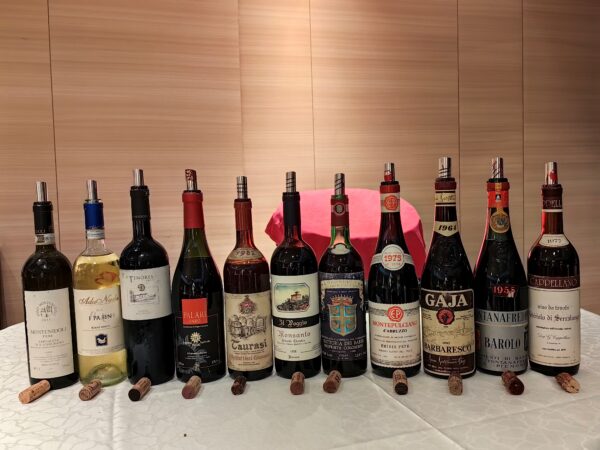
| A. Montenidoli, Vernaccia di San Gimignano Fiore, 2011 |
| B. Ada Nada, Roero Arneis I Parin, 2014 |
| 1. Dettori, Tenores, 2005 |
| 2. Palari, Faro, 2004 |
| 3. Molettieri Giovanni, Taurasi, 1982 |
| 4. Castello Di Monsanto, Chianti Classico Riserva, 1978 |
| 5. Fattoria dei Barbi, Brunello di Montalcino, 1975 |
| 6. Emidio Pepe, Montepulciano d’Abruzzo, 1975 |
| 7. Gaja, Barbaresco, 1964 |
| 8. Fontanafredda, Barolo, 1955 |
| 9. Cappellano, Nebbiolo d’Alba, 1977 |
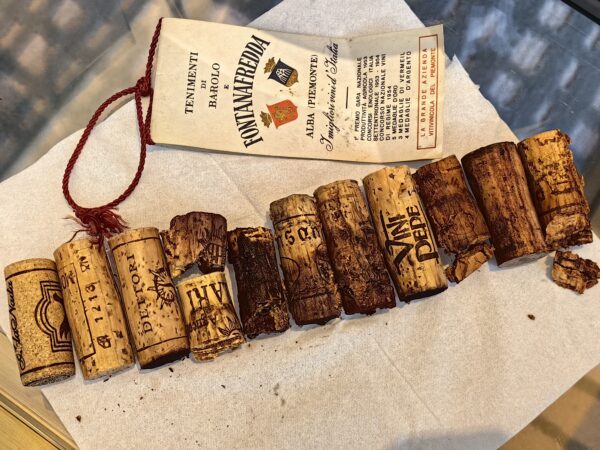
兩支新年份的紅我提前兩天開,每天都試一點觀其變化,其餘的酒一律一天前開瓶,對 1982 與 1955 我比較謹慎,小試後囘塞並等到第二天中午後再拔塞一直瓶醒到晚上。
為免報告寫得太長,這 11 支酒的故事我作爲附錄放在後面。
兩支白令大家眼前一亮。
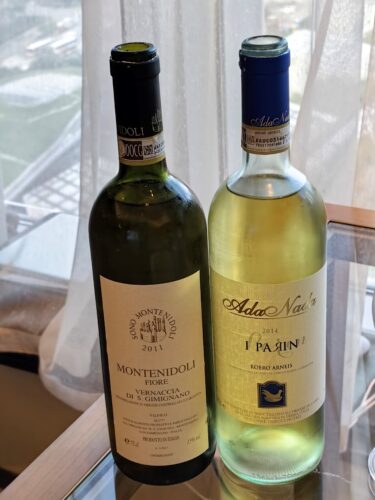
A. Montenidoli, Vernaccia di San Gimignano Fiore, 2011 是垂直型的,B. Ada Nada, Roero Arneis I Parin, 2014 卻作水平式的發展。
輕年份的萬巢花姑娘今天令人驚艷,完全打開了,噴著清新的花香,果與礦物也完全融合了,最妙的是那如貓咪般的輕盈步履,她輕撫著我們的鼻子與舌頭。今天 16 人喝,所以每人平均只可以喝一輪半。我兩個半小時後再添了一小杯,天呀,更花香撲鼻,我瞥見坐在我西北方向的朋友把鼻子埋在杯裏,驚嘆著:花海,花蜜!我跟大家說這等酒不像名氣酒,大概上市幾年後便喝光了,沒有幾個人會像我這樣有耐性放她十年的,但你今天可以做起!
B. Ada Nada, Roero Arneis I Parin, 2014 起初果味豐滿得幾乎汎濫,雨水較多的年份沒有太多的結構感可言,這份屬正常,不過老籐給了他很好的深度,這與萬巢的乾燥年份的輕盈形成很强烈的對比。到第二回合,礦物又製造了第二波的大潮,這時的果已變得如蜂蜜一樣强烈了。與七、八年前比,這款酒成熟多了,但我驚艷如一。
我們的 8 支紅從南往北走,年份越喝越舊。
最新年份的頭一雙來自意大利南部的兩大海島。我早兩天便開瓶來好好伺候他們。
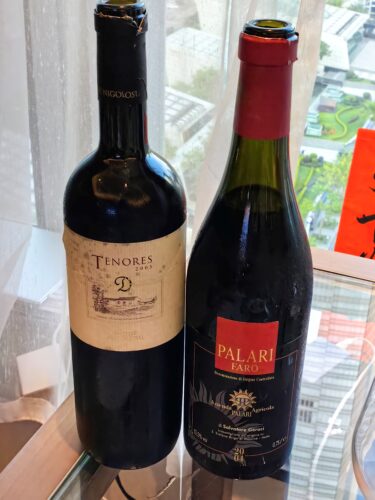 撒丁島(Sardinia)的 1. Dettori, Tenores, 2005 有著一貫的自然酒風味,酒精度常很高(這支 16%),剛開瓶那天是葉日,有 Cannonau(外面叫 Grenache)慣有的甜味,而且帶著點類似揮發性酸度的天那水氣味,入口有點刺喉,活像上世紀六七十年代英國的 punk 樂派(朋克)那樣,完全不修邊幅。第二天果日出了些香粉,多了些濃度,也沒有那麽刺喉了,到第三天晚上正式品試時,竟然一切都顯得比較 “正常”了,早兩天入口都有些空洞感,此時果味足夠得填滿了洞洞,而且不太感覺到 16 度的酒精,一種異域的甜美成爲他身份的標記。
撒丁島(Sardinia)的 1. Dettori, Tenores, 2005 有著一貫的自然酒風味,酒精度常很高(這支 16%),剛開瓶那天是葉日,有 Cannonau(外面叫 Grenache)慣有的甜味,而且帶著點類似揮發性酸度的天那水氣味,入口有點刺喉,活像上世紀六七十年代英國的 punk 樂派(朋克)那樣,完全不修邊幅。第二天果日出了些香粉,多了些濃度,也沒有那麽刺喉了,到第三天晚上正式品試時,竟然一切都顯得比較 “正常”了,早兩天入口都有些空洞感,此時果味足夠得填滿了洞洞,而且不太感覺到 16 度的酒精,一種異域的甜美成爲他身份的標記。
來自 Etna 火山脚下的 2. Palari, Faro, 2004 有類似 Etna Rosso 的焦土香氣,不過 Etna 清秀,位於山脚的他卻偏肥胖,還帶著濕漉漉的土壤氣息。我沒有仔細研究過,但我的舌頭告訴我這裏似乎比較多黏土,酒有種滯重的感覺,有朋友甚至懷疑是否用了風乾葡萄(答案:不是)。用 fine wine 的標準要求,這顯然不及 Etna。如果 Etna 是摘星的餐廳,那 Faro 就是路邊小舘,不講究排場,不精緻,但大魚大肉,什麽都不缺,只要你不講究丹寧結構,又或者酸度與果之間是否平衡,他的豐滿、圓潤、易喝、好喝是蠻討好的。
到了南部的 Campania 與中部的 Tuscany,我們找來兩位資深的代表。
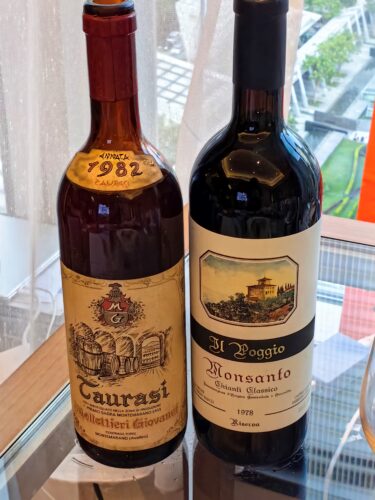 南部的天氣較熱,酒一般都偏濃,要靠高海拔才得以矯正,Etna 與 Taurasi 之所以例外,是因爲兩者地勢都較高,可以達到六、七百米。上面的 2. Palari, Faro, 2004 就因爲地勢低,出不了 Etna 的通透和結構感。
南部的天氣較熱,酒一般都偏濃,要靠高海拔才得以矯正,Etna 與 Taurasi 之所以例外,是因爲兩者地勢都較高,可以達到六、七百米。上面的 2. Palari, Faro, 2004 就因爲地勢低,出不了 Etna 的通透和結構感。
3. Molettieri Giovanni, Taurasi, 1982 是我幾年前在一場拍賣會發現的,我當時猜想 Giovanni 是 Salvatore Molettieri 的父親。Salvatore 的 Taurasi 我只喝過新年份,蠻好的,我好奇他的疑似父親是怎樣的。
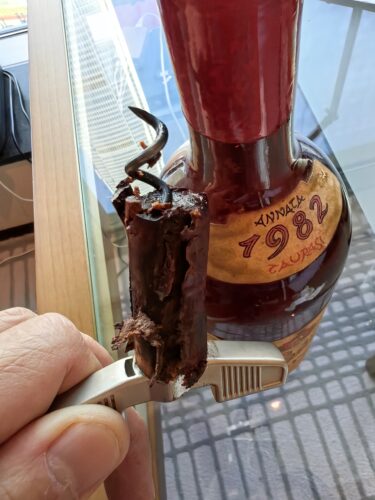 可惜這瓶酒的狀態是今天 11 瓶當中最差的,瓶塞霉爛得幾乎粉碎了,像他的身份一樣,我們只能猜他有多好。
可惜這瓶酒的狀態是今天 11 瓶當中最差的,瓶塞霉爛得幾乎粉碎了,像他的身份一樣,我們只能猜他有多好。
剛開瓶時活像酸梅湯,帶著很明顯的天那水氣味。第二天中午再小試,竟然有些帶著鹹味的香粉。晚上正式品試,酸梅湯變得更濃了。第一回合過後,Louis 聞了瓶子後連忙說瓶底有礦物味。我聽後傾盡瓶底倒了最後一杯,酸梅湯已換成超濃的果汁了,非常黏稠,但順滑得像塊很厚的天鵝絨,最驚人的是那凌厲的酸度,而這便是高海拔的 Taurasi 的標記。肉身壞了,靈魂卻不滅!
今天上半場的意外真不少。我指望 4. Castello Di Monsanto, Chianti Classico Riserva, 1978 會給大家一個大驚喜,可是這款皇牌 Chianti Classico 與 ’82 Taurasi 剛相反,狀態好得像個童子!我一天前小試,花香沉底,木香在上,入口最強是礦物,然後是酸度,最不足的是果。
第二天中午果多了些,到晚上非常通透,什麽都出一點,有種内發的張力和勁力,但完全欠缺細節,更不要說層次了。這是瓶 ex-Domaine(自出自酒莊窖藏),我十多年前便買下存倉,想不到今天的發展仍然慢得像冰川一樣。我以前開過很漂亮的 1978(見:VIPa-6 第 3 場 — 回歸 Chianti 之一:Monsanto),事實上 Monsanto 常常在 Chianti 的比試中奪魁,今天偏偏拿了另一個冠軍:陳年能力驚人!
下半場運氣好多了,精彩連連。
1975 在中部是個很好的年份,兩支狀態都非常好。
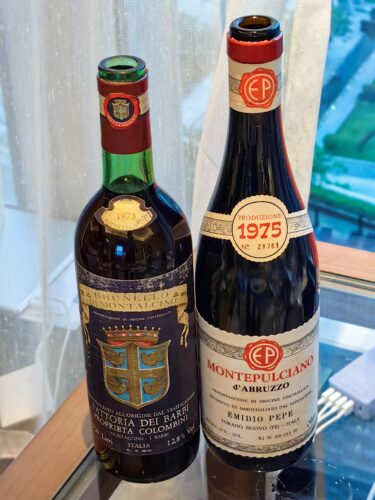 5. Fattoria dei Barbi, Brunello di Montalcino, 1975 熟透了,乾花,酸度帶給他非常好的活力,有種蹦蹦跳的感覺,乾净,順滑,亮堂堂的果,同樣亮麗的酸度,底部透著些檀香類的香木 — Bravo!
5. Fattoria dei Barbi, Brunello di Montalcino, 1975 熟透了,乾花,酸度帶給他非常好的活力,有種蹦蹦跳的感覺,乾净,順滑,亮堂堂的果,同樣亮麗的酸度,底部透著些檀香類的香木 — Bravo!
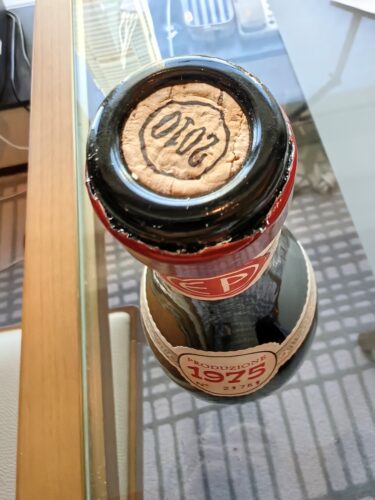 這支 6. Emidio Pepe, Montepulciano d’Abruzzo, 1975 也是瓶 ex-Domaine,有趣的是瓶塞上注明 2012,那應該是他們用換瓶方法來灌瓶的一年。第一天小試已非常好喝,純净,優雅,哪裏像南方來客?
這支 6. Emidio Pepe, Montepulciano d’Abruzzo, 1975 也是瓶 ex-Domaine,有趣的是瓶塞上注明 2012,那應該是他們用換瓶方法來灌瓶的一年。第一天小試已非常好喝,純净,優雅,哪裏像南方來客?
第二天晚上,超級通透與優雅,底色是涓涓細流的泥土味與礦物味。’78 Monsanto 應有的 Chianti Classico 和諧跑到這裏來了!餘韻很長,有人說好像一杯上好的中國茶。
座中有位 MdA 的鐵粉,他喝得可高興了,那麽老的年份還開得那麽好,對他是個奇跡,不過要知道這不是個尋常的 MdA 酒莊。
最後三支是 Nebbiolo 的世界,都超過 50 嵗,但絕對不是老人家。
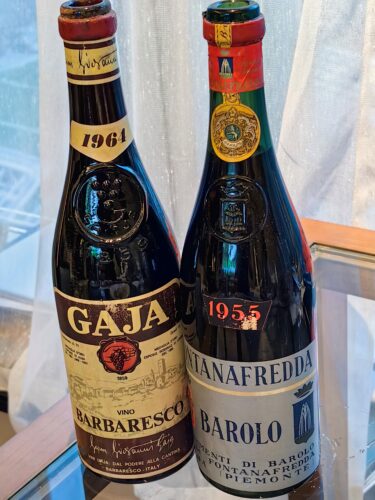 7. Gaja, Barbaresco, 1964 純粹是力量的表現,濃烈的礦物香氣帶著一點點燒焦的氣息,入口諸味紛陳,收結長之又長,酸度非常亮麗,那由礦物味建構的複雜度有幾分 Chambertin 的影子。這是 Angelo Gaja 主政前的傑作,很多棱角後來被他磨平了,所以這支是史前期的傑作,很難得今天嘗到了。
7. Gaja, Barbaresco, 1964 純粹是力量的表現,濃烈的礦物香氣帶著一點點燒焦的氣息,入口諸味紛陳,收結長之又長,酸度非常亮麗,那由礦物味建構的複雜度有幾分 Chambertin 的影子。這是 Angelo Gaja 主政前的傑作,很多棱角後來被他磨平了,所以這支是史前期的傑作,很難得今天嘗到了。
快七十嵗的 8. Fontanafredda, Barolo, 1955 更驚人。開瓶後小試有甘蔗與玫瑰,純净的果,活命的酸,驚艷!我生怕有變,便囘塞等到第二天中午再試。甜美,平靜得幾乎沒有丹寧,我記下了一句:心無挂礙。於是決定拔了塞子讓他繼續醒。
晚上他變得更複雜。大派玫瑰花,有人用 Sensory 杯子,花香更綻放。感覺沒有那麽果了,因爲出了很多礦物,讓他有了深度,連細細的丹寧也出了,有了脊梁骨!Barolo 的凍齡奇功大家見識了。
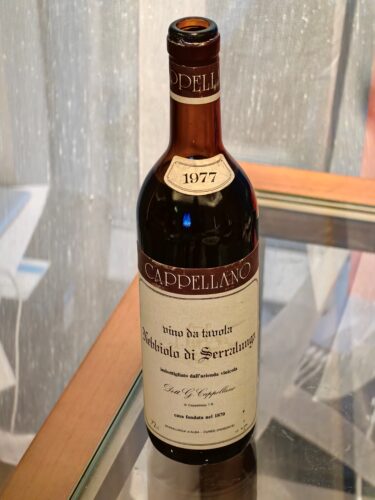 最後一支 9. Cappellano, Nebbiolo d’Alba, 1977 是臨時加的。我原來想用他們的 1958 Barolo,可是找不到,便換了 Fontanafredda 1955,並且加了這支 Nebbiolo d’Alba。其實這支比 Barolo 還要難找。幾年前開過一支 1978 Nebbiolo 便精彩萬分。
最後一支 9. Cappellano, Nebbiolo d’Alba, 1977 是臨時加的。我原來想用他們的 1958 Barolo,可是找不到,便換了 Fontanafredda 1955,並且加了這支 Nebbiolo d’Alba。其實這支比 Barolo 還要難找。幾年前開過一支 1978 Nebbiolo 便精彩萬分。
開瓶小試,乾净的果,還有丹寧,很活潑!
第二天晚上,感覺塞子帶來的一股老木頭氣味令酒有些不乾净,但除了這種難免的瑕疵以外,這年近五十的 Nebbiolo 表現也很難挑剔,由酸度領軍,丹寧殿後,清甜的果與輕輕的礦物居中,要什麽有什麽,我特別愛那通透感與丹寧的脊梁,那分明是 Serralunga 的派頭。
這也為我們這晚的偶遇劃上幾乎完美的句號。
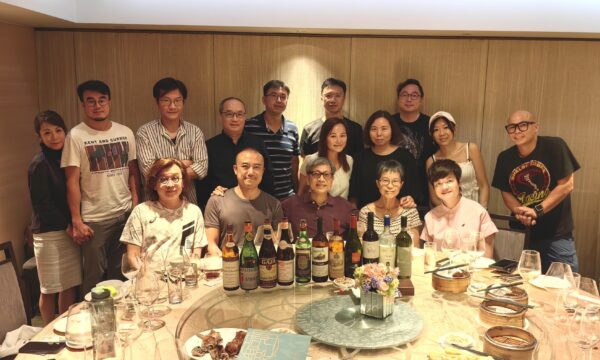
Wine of the Night
兩瓶白那麽精彩,所以我開放他們給大家投票。結果如下:
第一名:6. Emidio Pepe, Montepulciano d’Abruzzo, 1975(加權 29 分)
第二名:8. Fontanafredda, Barolo, 1955(加權 18 分)
第三名:9. Cappellano, Nebbiolo d’Alba, 1977(加權 14 分)
第四名:A. Montenidoli, Vernaccia di San Gimignano Fiore, 2011(加權 12 分)
第五名:7. Gaja, Barbaresco, 1964(加權 7 分)
附錄
15 篇小品的故事
| Wine | Information |
| A. Montenidoli, Vernaccia di San Gimignano Fiore, 2011 | Nicolas Belfrage proclaimed that “the essential ingredient of Elisabetta Fagiuoli’s wines is soul, and you can’t describe soul. You have to sense it, taste it, relate to it.” She was an enigma, and she still is. I could never have imagined that I would meet her at a wine fair and became ever since her admirer and good friend. She called my mother her sister. I lovingly penned a Chinese name for her estate – 萬巢之山。I wrote a lot about her, and this was the very first one: 漫步 2012 國際酒展(下)﹕夢遊萬巢之山
十八嵗 makes a lot of good wines, but her Fiore is the one I like the best. She would frown in disbelief whenever I told her this. |
| B. Ada Nada, Roero Arneis I Parin, 2014 | What did I see in Elisabetta’s soul? It’s LOVE – from her love of Christ extended to the entire human race — 大愛! What captivated me about Annalisa Nada (Ada is her mother) is her love for her family, carried from three generations down to her. All her wines bear the name of someone in the family (including the godfather-godson link), and they do not seem to care if others understand the meaning of each wine. I visited them and listened to their stories, and this one is about a godfather – “I Parin” in local dialects – see report of my first visit – 2015 意遊散記(十)﹕Ada Nada 的逍遙遊, and from it, I Parin:
2014 I PARIN Roero Arneis(1,300 瓶)﹕I Parin 是當地方言,「教父」的意思。 Arneis 是 Roero 有名的白葡萄,種植者是 Annalisa 的姨父名 Giovanni,是個快 80 歲的老人,因為兒子 Franco(Annalisa 的表兄弟)不想繼承釀酒事業,他只好賣掉酒莊與葡萄園,唯獨這塊 60 歲的田他不捨得賣,於是繼續耕種,並把葡萄交給外甥女釀酒,2014 是第一個年份。Giovanni 視葡萄為至親的孩子,每天要親撫他心愛的 Arneis。 酒稱為「教父」是因為 Franco 是 Annalisa 幼女 Emma 的教父,而 Annalisa 的丈夫 Elvio 又是 Franco 的兒子 Edoardo 的教父。 我沒喝過那麼濃郁的 Arneis,聞起來簡直有油的重量,入口複雜,收結長,蠻震撼的。要選我近一個月意大利旅程中最好的酒,這瓶一定位居三甲之列。 |
| 1. Dettori, Tenores, 2005 | The Sardinians are fiercely independent, and are proud of their identity. This shows clearly in their wines. I can never forget the utter astonishment on the face of my friends when five years ago, I let them taste what remained of a bottle of Dettori 2005 that was opened 20 months ago! See: VIPa-6 第 19 場 — Sardinia! |
| 2. Palari, Faro, 2004 | I became interested in Etna about 10 years ago, and when I visited Vinitaly in 2014 for the first time, my dual purpose was to taste as much as possible two regions: Etna and Valtellina (see report here: 2014 踏進意大利酒的世界(內篇之八)Vinitaly 5﹕Etna, Sicilia). When I came back, I studied Bill Nesto’s book on Sicilian wine, and found an online merchant in Sicilia and bought all the important wines mentioned in Bill’s book. I ended up with one room full of cheap but hard to find Sicilians. One friend said I had the most expensive Sicilian wines in Hong Kong, for the storage cost. And he was right.
You probably have had some Etna, so I pick one that is seldom found, from the Faro DOC, south of Etna, near Messina. Palari is an architect turned winemaker who revived this appellation. He had big fame, and I had a few bottles of his wine, but forgot what it was like. Hence this bottle.
It is a blend, led by about 50% Nerello Mascalese, the main grape of Etna Rosso, and augmented by several others. |
| 3. Molettieri Giovanni, Taurasi, 1982 | Another of our Italy travel reignited my interest in Taurasi. I fondly remember that I aroused the Salvatore’s interest when I said that Barolo is the Taurasi of the North, and then he proposed to take us on a tour of his beloved vineyards. (see: 2016 意遊速記(四)﹕尋找 David(下)— Salvatore Molettieri’s Cinque Querce).
I bought this bottle from an auction. I suspect it was made by Salvatore’s father. A precious bottle quite unknown here and elsewhere. |
| 4. Castello Di Monsanto, Chianti Classico Riserva Il Poggio, 1978 | I believe Chianti is the most underrated and least understood historic wine region in Italy. For this reason, and to satisfy my curiosity, I ran a 9-event series from 2019 to 2020 exploring every commune and some iconic producers.
I was happy to see doubters converted to believers, and there was one event in which a novice asked me: can Chianti really age? In that event, we had a 1978 Monsanto. One more conquered, easily. (See: VIPa-6 第 3 場 — 回歸 Chianti 之一:Monsanto)
There are many stars in Chianti, but Monsanto surprised me as being a perennial winner. |
| 5. Fattoria dei Barbi, Brunello di Montalcino, 1975 | This is cheap stuff for its big production, but also because its fame does not keep up with its history. But for a great vintage like 1975, it amply displays the aging power of Brunello. I hope the bottle condition is as good as the one I charmed and almost shocked a Shanghai fan who visited me 8 or 9 years ago. |
| 6. Emidio Pepe, Montepulciano d’Abruzzo, 1975 | This bottle brings back fond memories of a departed friend and colleage, who inducted me into Bordeaux but was conquered by this eccentric Italian (see: 吾友 Enrico). On this evening, my friend Henry preferred this to a 1979 Latour. |
| 7. Gaja, Barbaresco, 1964 | No one can dismiss Gaja, winemakers and wine lovers alike. One of my earliest, pre-VIPa studies was of this legend (see: Angelo’s Choice). I concluded that if he made wines in the traditional fashion, he could be as good as any. But his business ambitions led him to court the rulers of taste, and he ended up as the one and only one Gaja, who a lot love, and some love to hate.
I revisited Gaja in 2019 VIPa-7 第 7 場 — Vintage Gaja and I was as biased as ever.
This 1964 was from the pre-Angelo Gaja period. |
| 8. Fontanafredda, Barolo, 1955 | Fontanafredda is one of the oldest wine estates, and in fact founded in 1858 by the first King of modern Italy. It is a very large estate, with holdings in the northernmost part of Serralunga, but it has always had a large production, by buying grapes from the large number of growers who did not make their own wines at that time.
Bruno Giacosa followed his father and started as a grape broker, and it is large clients like Fontanafredda that he served. In fact, it is from this experience that he gained knowledge about the vineyards in Barolo and Barbaresco. Gigi Rosso, a good friend of Bruno, was another one before he bought Arione and became a winemaker himself, in the 1970s |
| 9. Cappellano, Nebbiolo d’Alba, 1977 | Cappellano is a legend, mostly due to 4-th generation Teobaldo Cappellano, who took the reins in 1970, and slowly rebuilt and transferred the firm from a big company into a boutique winery. He was famous for asking critics not to score their wines, as he did not want comparison with his neighbors. This 1977 represents an early work of Teobaldo, and is very rare, more difficult to find than their Barolos. See: 追夢者 Teobaldo Cappellano and VIPa-10 第 4 場 — 3 Generations of Cappellano.
I also had a wonderful 1978 Nebbiolo – in fact, one of my best 1978 Nebbiolo even counting Barolos and Barbarescos as the opening wine for this event: VIPa-8 第 16 場 — Giacosa Lives(5):Giacosa’s Favorite Barolos |